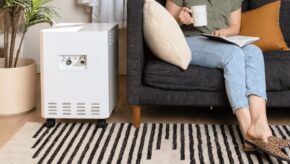The outbreak of the pandemic Coronavirus disease (COVID-19), a highly contagious respiratory disease, has brought a new light to cleanliness practices and preventative mitigation methods that can be used in not only daily life, as well as in all medical settings. The development of this contagious disease has rapidly become a public health crisis that has spread exponentially throughout the world, which has called for many Countries to go on a public lockdown to fight to stop the spread. However, during this time many essential businesses must remain open during this pandemic, to give people access to the products and services that they need like grocery stores, public transportation, hospitals, and other medical facilities such as urgent care facilities, doctor’s offices, and dental practices,
The widespread transmission of COVD-19 has become a risk not only for the everyday American, but also to those health care providers who are having extreme levels of contact with patients during this pandemic outbreak. The American Association of Endodontists (AAE) have stated that dental professionals, in particular, are experiencing high risks for nosocomial infection and even have the potential to become carriers of this disease. Dental professionals increased exposure risks to this highly infectious respiratory disease stems from this healthcare workers close contact and proximity to a patient’s oropharyngeal region – which can include aerosol generation of saliva within the air space of this dental setting.
In this article we are going to discuss the impact of infectious diseases on dental professionals and their offices, as well as understand the important of patient management and prevention of these contagious diseases within dental settings, such as the integration of air purification devices for airborne pathogen containment and destruction.
Understanding the Coronavirus Outbreak
Originating in Wuhan, China, the Coronavirus disease has steadily evolved into a global public health crisis, as it has spread aggressively to other parts of the world, including the United States. Coronaviruses are a type of virus that contain many different kinds, and some of these Coronaviruses will cause disease, like the recently identified COVID-19 infectious respiratory illness. John Hopkins Medicine stated the following about the spread of the new Coronavirus, “Researchers have identified that the new Coronavirus is spread through droplets that are released into the air when an infected person coughs or sneezes, and these droplets will generally not travel further than a few feet – and they will fall to the ground or other surfaces within a few seconds.”
As this new pandemic virus began its descent into the world, specifically public health, officials in the healthcare field have been extensively tracing the exact source of this newly introduced Coronavirus. The novel Coronavirus has been linked to a family of single-stranded RNA viruses known as Coronaviridae, a family of viruses that are known to be zoonotic and therefore transmitted from animals to humans, from findings published in the Virus Taxonomy. The strongest evidence has linked this novel Coronavirus to similar Coronavirus species found in bats, which confirms the zoonotic nature of this new cross-species Coronavirus that we are battling across the country, as well as throughout the world.
Impact of Coronavirus on the American Dental Association
Dental emergencies can arise frequently and will require treatment by a dental professional immediately. These dental emergencies still take place, even during a pandemic like COVID-19, which has been found by the American Association of Endodontists (AEE) and the Centers for Disease Control and Prevention (CDC) to be a potential health risks to dental professionals across the world. The progression and spread of this contagious respiratory disease have led to the American Dental Association to release new information handouts for dentist on the Coronavirus and strategies on how to prevent the transmission of this virus specifically in the dental health care setting.
The Coronavirus has been shown to survive in aerosols for hours and on surfaces for days, and thus the lifespan of this virus can be compromising to many environments, including dental offices, as the American Dental Association has highlighted in their ADA Coronavirus Handout published in February 2020. This collected information from the American Dental Association (ADA) and the Centers for Disease Control and Prevention (CDC), who they collected information from in their published handout, have both encouraged that because of the dangerous transmission risks to dental professionals, that all dental practices only provide emergency and other essential care to patients during this pandemic. Therefore, strongly suggesting that elective treatment and other elective dental work be postponed to minimize the risks levels for dental care workers to the pandemic COVID-19 virus, according to Dentistry Today.
How Are Diseases Transmitted in Dental Settings
The Centers for Disease Control and Prevention discussed the impact that the Coronavirus can have on dentistry practices and the dental professionals in this field. Dental procedures and other dental practices used in these medical practices today use rotary dental and surgical instruments like handpieces or ultrasonic scalers and air-water syringes. Although these instruments are essential in the dental industry, the CDC illustrates that they can all create a visible spray that will contain a mixture of large particle droplets of water, saliva, blood, microorganisms, and other debris within this aerosolized spray. This aerosolized spray produced within dental settings can only travel short distances within this indoor space, however, they will eventually settle quickly on surfaces in the space like desks, floor, operatory surfaces, the dental professional, or the patient.
Dr. John T. Grbic, DMD, a professor of Dental Medicine at Columbia University Medical Center in New York, expressed the significant issues with COVID-19 and dental professionals exposure levels, according to WebMD. He stated the following regarding the aerosolization of COVID-19 in the air immediately following dental procedures that use drill or ultrasonic scalers,
“A recent study suggests that COVID-19 remains in the air anywhere from 30 minutes to three hours. This could be a risk to both the dental staff and the paitent.”
Dentists and other dental professionals already have specific protocols in place that they follow to minimize exposure and their patients’ exposure to infectious materials during treatment. However, when dealing with a highly infectious respiratory virus, like COVID-19, transmission can spread through many different routes including through respiratory droplets produced by coughing or sneezing that spread in the air or through contact with infected items that the virus can land on such as in areas around the dental practice – as we have already highlighted above. Thus, the potential transmission of COVID-19 via aerosol, fomites, or fecal-oral route can all be potential transmission routes to nosocomial spread in a dental office setting, as stated in the Publication titled Transmission Routes of 2019-nCoV and Controls in Dental Practice.
Dental Care of Patients with Infectious Respiratory Problems
All dental settings, regardless of the level of care provided, must make infection prevention a priority within their medical facility – this will include having proper PPE equipment and follow recommended guidelines provided by the CDC Guidelines for Infection Control in Dental Health-Care Settings. Standard precautions are the basis of this infection prevention practices when caring for a patient with an infectious respiratory problem. These basic practices are designed to protect both the dental professional and prevent the dental worker from spreading the infection among patients. These standard precautions will include hand hygiene, use of PPE (gloves, masks, eyewear), respiratory hygiene/cough etiquette, safe injection practices, sterile instruments and devices, and clean and disinfected environmental surfaces – according to the CDC Guidelines provided for Infection Control in Dental Settings.
Additionally, sterilization and disinfection of patient-care items and devices is important to controlling the spread of infectious respiratory viruses and diseases. Each dental practice will have specific policies and procedures in place for containing, transporting, and handling these instruments and equipment that may be contaminated by blood or bodily fluids. These disinfection and sterilization procedures must be implemented for any surface, supplies, or equipment that are located within 7 feet of a symptomatic patient, the CDC states in its Interim Infection Prevention and Control guide for Dental Settings During the COVID-19 Response publication.
Signs & Symptoms of Infectious Diseases (COVID-19)
If a patient has a dental emergency and must been seen in a dental clinic for emergency care, it is necessary to assess the patient at the time of check-in for infectious disease symptoms and signs. The Washington State Department of Health illustrated the importance of screening patients to determine the presence of symptoms of a respiratory infection and a history of travel to areas with a high level of infectious disease exposure, particularly with regards to the global pandemic COVID-19 that is spreading throughout the Country. The CDC indicated that a patient whose body temperature reads to be under 100.4 degrees Fahrenheit and otherwise without symptoms that are consistent with COVID-19 can be provided emergency dental care using the appropriate engineering controls, work practices, and infection control practices.
The signs and symptoms that are consistent with Coronavirus (COVID-19), reported by the American Association of Endodontists (AAE), found that clinical symptoms will include fever, cough, and myalgia. Additionally, these infected individuals will also have abnormal chest X-Rays when screened for the infection prior to dental work. An estimated 80% of patients with COVID-19 have only mild symptoms from this pandemic virus, and these symptoms will resemble flu-like symptoms and seasonal allergies.
Patient Management and Prevention of Contagious Diseases in Dental Settings
Patient management and prevention strategies to mitigate contagious diseases in dental settings are vital, especially during infectious respiratory viruses like the COVID-19 pandemic. As we discussed previously, in response to this global pandemic, the American Dental Association has issued a recommendation for dentists to postpone elective procedures for the next couple weeks and instead only provide treatment for dental emergencies needed by their patients’. However, when handling these dental emergencies proper screening and prevention methods are important to take to ensure the safety of both the dental professionals and their patients. Dentists should always follow standard, contact, and airborne precautions, including the use of PPE (personal protective equipment) and hand hygiene practices, illustrated in the current CDC guidelines for dental practices. Additionally, the use of disposable (single use) devices such as moth mirror, syringes, and blood pressure cuffs to prevent cross contamination.
Another important consideration is the risk of airborne infection present in the airspace of the dental office. As we discussed previously, the American Association of Endodontists stated that the human coronavirus can survive on inanimate surfaces up to 9 days at room temperature, as well as be aerosolized in the air for anywhere from 30 minutes to three hours. Therefore, having proper preventive mitigation solutions within this dental setting could be beneficial in the contaminant and purification of airborne pathogens emitted within the air of this medical space.
Advanced Air Purification for Chemicals, Odors, and Pathogens
The spread of pathogens between humans falls into direct or indirect contact; through airborne transmission, contaminated object and surface contact, and food and drinking water contamination. These three routes of indirect spread are often the result of contamination by the spray of droplets during coughing and sneezing, which can facilitate the spread of an infectious disease. Aerosolized droplets from humans range in size from .6 microns to over 1000 microns, collected from research published in the Characterizations of Particle Size Distribution of the Droplets Exhaled by Sneeze publication. Thus, the threat of exposure to an airborne pathogen can be potentially more significant, especially in certain medical care facilities such as dental settings.
Additionally, Ultraviolet light (UV light) is a known method for the inactivation or reduction in viability of pathogens, according to the CDC’s Infection Control Guidelines. However, the correct wavelength and control measures must be considered to avoid damage to the skin and eyes, as many UV light wavelengths can produce dangerous wavelengths that will ultimately produce ozone – a dangerous byproduct – within the indoor air space, reported by the American Cancer Society. Many air purification devices contain these UV lights to enable the capability to deactivate these airborne pathogens within the air purification system, but unfortunately a vast majority of these UV lights used in air purifiers fall within these hazardous wavelength production ranges which allow for the creation of ozone byproducts in the air.
The EnviroKlenz UV System solves the dosage problems by placing the UV-C light before the HEPA filter which captures biological contaminants 0.3 microns and larger. The droplet size from coughing or sneezing humans is very broad, and a HEPA filter can capture the bulk of that particulate matter range. Integrating UV lamps within the air purification device allows for continual bathing of the collection site of the HEPA filter, which allows for the items collected on the surface of the HEPA filter to get a lengthened or even infinite residence time. In the EnviroKlenz Mobile Air System with UV lights, the pathogens are exposed to the UV-C light as long as the unit and its lights remain on in the air purification system.
This means that even though the UV lamp is relatively low intensity, given the airflow of the unit (approximately 80-250 cfm), the UV-C dosage required for destruction is created for the trapped pathogen because it will continue to be exposed to the UV-C radiation regardless of how quickly air is passing through the unit.
Table. Plaque forming units after exposure of MS2 to metal oxides formulations. (Standardized data)
The bacteriophage MS2 (a simulant of a human virus) was initially propagated by inoculating a rehydrated aliquot of MS2 into a culture host of E. coli and incubating with shaking in nutrient broth. Bacteriophage replicate by infecting the host bacteria and passing their genetic code into the host cell where the cell replicates phage. In turn the new generation of phage lyse the cell wall of their host escaping into the surrounding media furthering the propagation in unexposed host cells. To ensure no further interaction of MS2 and host cells after propagation of phage, the culture was centrifuged to remove cell debris and sterile filtered.
A plaque titer assay was performed to enumerate the propagated MS2 bacteriophage. The number of MS2 phage per mL in this stock culture was determined by plating E. coli host culture. Negative and positive control plates for the titer assay were performed prior to and after plating the diluted MS2 stock culture samples to provide evidence that host culture and diluent were not contaminated, and that bacteriophage were present in the MS2 stock culture.
Positive and negative control tests were performed. All high surface area MgO samples tested exhibited a formula dose related response to the metal oxide formulation. In addition, a time of exposure response of the bacteriophage to all three powder concentrations was evident. In the 5 minutes exposure test completely inhibited the MS2 bacteriophage’s ability to replicate at the formula concentration of 10 mg and 1 mg/ml. As for the 90 minutes exposure tests, bacteriophage inhibition was increased at the 100 ug/ml testing. It is concluded that metal oxide formations have disinfecting ability towards MS2.
References:
- American Association of Endodontists (AAE): Coronavirus Disease 19(COVID-19): Implications for Clinical Dental Care (link)
- John Hopkins Medicine: What is Coronavirus? (link)
- Virus Taxonomy, 2012: Coronaviridae (link)
- American Dental Association (ADA): ADA Releases Coronavirus Handout for Dentists Based on CDC Guidelines (link)
- ADA Center for Professional Success: ADA Coronavirus (COVID-19) Center for Dentistry (link)
- Dentistry Today: Dental Professionals Face Higher Risks of COVID-19 Exposure (link)
- Centers for Disease Control and Prevention (CDC): Interium Infection Prevention and Control Guidance for Dental Settings During the COVID-19 Response (link)
- WebMD: Dental Emergencies During COVID-19 Pandemic: Everything You Need to Know (link)
- International Journal of Oral Science: Transmission Routes of 2019-nCoV and Controls in Dental Practice (link)
- Centers for Disease Control and Prevention (CDC): Summary of Infection Prevention Practices in Dental Settings (link)
- Washington State Department of Health: COVID-19 Health Alert for Dental Providers (link)
- Journal of the Royal Society Interface: Characterizations of Particle Size Distribution of the Droplets Exhaled by Sneeze (link)
- Centers for Disease Control and Prevention (CDC): Guidelines for Disinfection and Sterilization in Healthcare Facilities (2008) (link)
- American Cancer Society: Ultraviolet (UV) Radiation (link)
UV Mobile Air System
Providing Advanced Air Purification For Dental Offices
✓ Patented earth mineral technology works to attack VOCs and break them down on a compound level
✓ No chemicals or masking agents
✓ Priority shipping for dentists
✓ Will not release any chemicals back into your environment
✓ UVC lamps are continuously shining on the collected organisms with high effeciency of kill and destruction
✓Financing and split pay options available
EnviroKlenz® Medical Disclaimer:
“Any information that is provided on this website is not for the use by any commercial or personal entity without expressed written consent of the blog author. The material and statements illustrated within this blog are not intended to diagnose, treat, cure, or prevent any diseases or medical conditions. Nor does the author in any way guarantee or validate the validity, totality, or efficacy of any claims and will therefore not be held responsible for the content of any claims. Always consult your medical physician for any specific medical advice or recommendations.”








